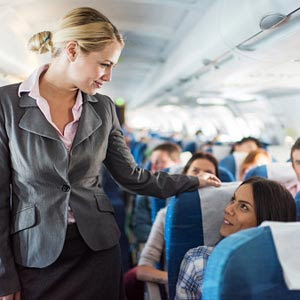| Flier Beware: Taking Photos Can Get You Kicked Off Your Flight
 Before you snap that photo to capture a memorable sight on your next flight, think twice. It could get you kicked off the plane!
Just ask Matthew Klint. He’s a seasoned frequent flier who writes a travel blog called “Live and Let’s Fly” and has been featured in numerous major news publications. After boarding a United Airlines flight from Newark to Istanbul, Klint took a snapshot with his iPhone of the video monitor on the back of the seat in front of him. It said, “Welcome Aboard. Sit back, relax, and enjoy your flight.”
No sooner had he clicked the shutter when a flight attendant rushed over and informed him he could not take pictures in the cabin. She referred him to a statement in Hemisphere magazine that said photographs of “airline personnel, aircraft equipment or procedures is always prohibited.” The statement further said that any photography of any kind on a United Airlines aircraft is “strictly prohibited, except to the extent specifically permitted by United Airlines.”
Here’s a Special Message From Our Friends
|
According to Klint’s account, which he says was corroborated by other passengers on the flight, he quietly put away his phone and took no more pictures. Shortly afterward, a ground agent called him aside and advised him that the captain was “not comfortable” having him on the flight and he would have to leave the plane. Klint asked to speak to the captain, who told him he was not going to fly on that plane and threatened to call police if he didn’t leave the plane immediately.
Arash Shirazi was waiting for a flight to LA from Reagan International in Washington, D.C., and snapped a photo of an American Airlines aircraft. He was immediately accosted by a gate agent who demanded to know why he was taking pictures of airport equipment. Shirazi apologized, saying he didn’t know it was not allowed, showed her the picture, and offered to delete it. But the agent combatively accused him of being a security threat and told him she was going to document this “security breach” in his travel record.
In a Washington Post report, Christopher Elliott, National Geographic Travellers reader advocate, noted that American Airlines doesn’t publish any prohibitions against taking photos of its aircraft but updated its internal policies last year to allow employees at ticket counters, gates, cargo, baggage, and onboard aircraft to stop passengers from taking pictures “to protect employees and customers,” according to Andrea Huguely, an American Airlines spokeswoman.
Other incidents have been reported of passengers who have run afoul of confusing airline policies regarding photography in the air travel environment. Some airlines publish their rules, but the notices are not prominently displayed and are hard to find even if you’re looking for them. Others do not make their photography policies public.
Elliot wrote that “When pressed, most airlines say that their policies allow cameras to be used onboard to record a ‘personal’ event, but that snapshots of the crew, other passengers, or any security procedure are off-limits.”
Can the airlines stop you from shooting pictures and even arbitrarily kick you off a flight just for taking a snapshot?
Turns out, they can.
Legally, their planes are considered private property, so they can make whatever rules they want about taking pictures on their property. Attorney Daniel Greenberg, who specializes in photography rights issues, explained to Elliott that “You can’t prohibit photography in public. But the prohibition of photography on private property is legitimate. That decision is up to the property owner. If you don’t want to follow the carrier’s rules, don’t get on the carrier’s plane.”
In a report for NPR, Martin Caste cited an explanation about the legal status of the photography rules from Jeff Hermes, director of the Digital Media Law Project at Harvard’s Berkman Center. Hermes said the airlines are within their rights because the plane is a private space, so they can make the rules. And if you violate those rules, whether you’re aware of them or not, you could be guilty of a form of trespassing.
The airlines typically say their concern about photography around their equipment is for security or privacy reasons. But another obvious concern is that they don’t want any videos or photos of unflattering incidents to go viral and damage their reputations. Mickey Osterreicher, general counsel at the National Press Photographers Association, said, “News these days is just as likely to come from somebody with a cellphone camera as somebody with a press credential.”
So if you have the urge to capture the moment with your camera, mind your P’s and Q’s if you don’t want to suffer the embarrassment and inconvenience of getting kicked off a flight.
Experienced travelers offer some tips on staying out of trouble when taking pictures around airline property. For starters, don’t shoot pictures of other people, including other passengers but especially not airline employees (unless you ask for and receive their permission). Even taking a selfie could be problematic if other people are in the shot. Be unobtrusive and try not to draw attention to yourself. Keep a low profile.
If you’re confronted by an airline employee and asked to stop taking pictures, don’t make a scene. Just comply. You’re on their turf, with their rules. Attorney and photography Jeffrey Loop says, “If you are taking photos on the aircraft and are asked to stop, don’t argue or take offence. Just stop and save yourself a heap of potential trouble. Arguing with cabin crew about your perceived rights will almost always be a losing proposition.”
Sources:
http://www.stuff.co.nz
http://www.npr.orghttp://www.diyphotography.net |

